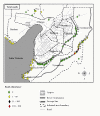Malacological survey and geographical distribution of vector snails for schistosomiasis within informal settlements of Kisumu City, western Kenya
- PMID: 22152486
- PMCID: PMC3247081
- DOI: 10.1186/1756-3305-4-226
Malacological survey and geographical distribution of vector snails for schistosomiasis within informal settlements of Kisumu City, western Kenya
Abstract
Background: Although schistosomiasis is generally considered a rural phenomenon, infections have been reported within urban settings. Based on observations of high prevalence of Schistosoma mansoni infection in schools within the informal settlements of Kisumu City, a follow-up malacological survey incorporating 81 sites within 6 informal settlements of the City was conducted to determine the presence of intermediate host snails and ascertain whether active transmission was occurring within these areas.
Methods: Surveyed sites were mapped using a geographical information system. Cercaria shedding was determined from snails and species of snails identified based on shell morphology. Vegetation cover and presence of algal mass at the sites was recorded, and the physico-chemical characteristics of the water including pH and temperature were determined using a pH meter with a glass electrode and a temperature probe.
Results: Out of 1,059 snails collected, 407 (38.4%) were putatively identified as Biomphalaria sudanica, 425 (40.1%) as Biomphalaria pfeifferi and 227 (21.5%) as Bulinus globosus. The spatial distribution of snails was clustered, with few sites accounting for most of the snails. The highest snail abundance was recorded in Nyamasaria (543 snails) followed by Nyalenda B (313 snails). As expected, the mean snail abundance was higher along the lakeshore (18 ± 12 snails) compared to inland sites (dams, rivers and springs) (11 ± 32 snails) (F(1, 79) = 38.8, P < 0.0001). Overall, 19 (1.8%) of the snails collected shed schistosome cercariae. Interestingly, the proportion of infected Biomphalaria snails was higher in the inland (2.7%) compared to the lakeshore sites (0.3%) (P = 0.0109). B. sudanica was more abundant in sites along the lakeshore whereas B. pfeifferi and B. globosus were more abundant in the inland sites. Biomphalaria and Bulinus snails were found at 16 and 11 out of the 56 inland sites, respectively.
Conclusions: The high abundance of Biomphalaria and Bulinus spp. as well as observation of field-caught snails shedding cercariae confirmed that besides Lake Victoria, the local risk for schistosomiasis transmission exists within the informal settlements of Kisumu City. Prospective control interventions in these areas need to incorporate focal snail control to complement chemotherapy in reducing transmission.
Figures


Similar articles
-
Distribution and seasonal abundance of Biomphalaria snails and their infection status with Schistosoma mansoni in and around Lake Tana, northwest Ethiopia.Sci Rep. 2022 Oct 12;12(1):17055. doi: 10.1038/s41598-022-21306-0. Sci Rep. 2022. PMID: 36224227 Free PMC article.
-
Spatial and seasonal distribution of Bulinus globosus and Biomphalaria pfeifferi in Ingwavuma, uMkhanyakude district, KwaZulu-Natal, South Africa: Implications for schistosomiasis transmission at micro-geographical scale.Parasit Vectors. 2021 Apr 23;14(1):222. doi: 10.1186/s13071-021-04720-7. Parasit Vectors. 2021. PMID: 33892778 Free PMC article.
-
Distribution of the schistosome intermediate snail host Biomphalaria pfeifferi in East Africa's river systems and the prevalence of Schistosoma mansoni infection.Trans R Soc Trop Med Hyg. 2025 Mar 7;119(3):253-265. doi: 10.1093/trstmh/trae115. Trans R Soc Trop Med Hyg. 2025. PMID: 39656884 Free PMC article.
-
Mapping of intermediate host snails for schistosomiasis in the Democratic Republic of Congo: a systematic review.Folia Parasitol (Praha). 2024 May 6;71:2024.010. doi: 10.14411/fp.2024.010. Folia Parasitol (Praha). 2024. PMID: 38841845
-
Implications of Changing Temperatures on the Growth, Fecundity and Survival of Intermediate Host Snails of Schistosomiasis: A Systematic Review.Int J Environ Res Public Health. 2017 Jan 13;14(1):80. doi: 10.3390/ijerph14010080. Int J Environ Res Public Health. 2017. PMID: 28098789 Free PMC article.
Cited by
-
Distribution and seasonal abundance of Biomphalaria snails and their infection status with Schistosoma mansoni in and around Lake Tana, northwest Ethiopia.Sci Rep. 2022 Oct 12;12(1):17055. doi: 10.1038/s41598-022-21306-0. Sci Rep. 2022. PMID: 36224227 Free PMC article.
-
A geospatial analysis of local intermediate snail host distributions provides insight into schistosomiasis risk within under-sampled areas of southern Lake Malawi.Parasit Vectors. 2024 Jun 27;17(1):272. doi: 10.1186/s13071-024-06353-y. Parasit Vectors. 2024. PMID: 38937778 Free PMC article.
-
Abundance and Annual Distribution of Freshwater Snails and Some Trematode Cercariae at Damietta Governorate, Egypt.Helminthologia. 2021 Sep 30;58(3):233-247. doi: 10.2478/helm-2021-0026. eCollection 2021 Sep. Helminthologia. 2021. PMID: 34934387 Free PMC article.
-
Prevalence and intensity of Schistosoma mansoni infections among schoolchildren attending primary schools in an urban setting in Southwest, Ethiopia.BMC Res Notes. 2017 Dec 4;10(1):677. doi: 10.1186/s13104-017-3023-9. BMC Res Notes. 2017. PMID: 29202865 Free PMC article.
-
Association between CD4+ T-lymphocyte counts and fecal excretion of Schistosoma mansoni eggs in patients coinfected with S. mansoni and human immunodeficiency virus before and after initiation of antiretroviral therapy.Am J Trop Med Hyg. 2013 Jul;89(1):42-5. doi: 10.4269/ajtmh.13-0045. Epub 2013 May 13. Am J Trop Med Hyg. 2013. PMID: 23669231 Free PMC article.
References
-
- Handzel T, Karanja DMS, Addiss DG, Hightower AW, Rosen DH, Colley DG, Andove J, Slutsker L, Secor WE. Geographic distribution of schistosomiasis and soil-transmitted helminths in western Kenya: implications for antihelminthic mass treatment. Am J Trop Med Hyg. 2003;69:318–323. - PubMed
-
- Standley CJ, Adriko M, Arinaitwe M, Atuhaire A, Kazibwe F, Fenwick A, Kabatereine NB, Stothard JR. Epidemiology and control of intestinal schistosomiasis on the Sesse Islands, Uganda: integrating malacology and parasitology to tailor local treatment recommendations. Parasit Vectors. 2010;3:64. doi: 10.1186/1756-3305-3-64. - DOI - PMC - PubMed
-
- Steinauer ML, Mwangi IN, Maina GM, Kinuthia JM, Mutuku MW, Agola EL, Mungai B, Mkoji GM, Loker ES. Interactions between natural populations of human and rodent schistosomes in the Lake Victoria region of Kenya: a molecular epidemiological approach. PLoS Negl Trop Dis. 2008;2:e222. doi: 10.1371/journal.pntd.0000222. - DOI - PMC - PubMed
-
- Kahigi WN. MSc thesis. Kenyatta University, Nairobi; 2000. Snail vectors of Schistosoma mansoni: Dynamics, infection and re-infection rates in individuals occupationally exposed to Lake Victoria waters in Kisumu Municipality.
Publication types
MeSH terms
LinkOut - more resources
Full Text Sources
Research Materials
Miscellaneous

